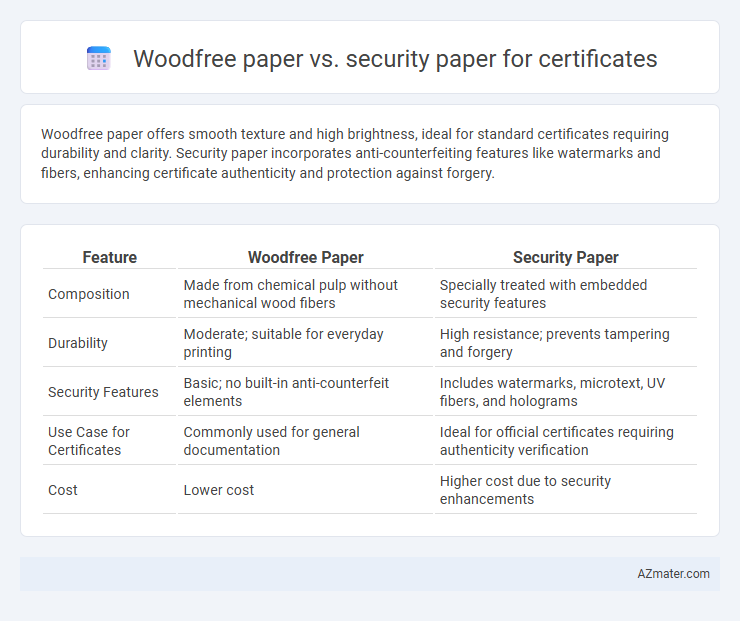Woodfree paper offers smooth texture and high brightness, ideal for standard certificates requiring durability and clarity. Security paper incorporates anti-counterfeiting features like watermarks and fibers, enhancing certificate authenticity and protection against forgery.
Table of Comparison
| Feature | Woodfree Paper | Security Paper |
|---|---|---|
| Composition | Made from chemical pulp without mechanical wood fibers | Specially treated with embedded security features |
| Durability | Moderate; suitable for everyday printing | High resistance; prevents tampering and forgery |
| Security Features | Basic; no built-in anti-counterfeit elements | Includes watermarks, microtext, UV fibers, and holograms |
| Use Case for Certificates | Commonly used for general documentation | Ideal for official certificates requiring authenticity verification |
| Cost | Lower cost | Higher cost due to security enhancements |
Introduction to Certificate Paper Types
Woodfree paper, commonly used for certificates, offers a smooth surface and high brightness that enhances print clarity and durability, making it ideal for professional presentations. Security paper incorporates specialized features such as watermarks, microtext, and anti-copy patterns to protect certificates from forgery and unauthorized duplication. Choosing between woodfree and security paper depends on the balance between aesthetic quality and the level of fraud prevention required for the certificate.
What is Woodfree Paper?
Woodfree paper, commonly used for certificates, is a high-quality, bright, and smooth paper made primarily from chemical pulp with lignin removed to prevent yellowing over time. Unlike security paper, which incorporates embedded features like watermarks, microtext, or special fibers to prevent forgery, woodfree paper emphasizes durability and a clean, professional appearance without anti-counterfeiting elements. Its acid-free composition ensures longevity, making it ideal for official documents that require a classic look rather than enhanced security measures.
What is Security Paper?
Security paper is a specially manufactured paper designed to prevent tampering, counterfeiting, and unauthorized reproduction of important documents such as certificates. It incorporates features like watermarks, microtext, holograms, and UV-reactive elements to provide authentication and protection against forgery. Unlike woodfree paper, which is primarily made from chemical pulp for smoothness and brightness, security paper emphasizes document integrity and fraud prevention in official records.
Key Features of Woodfree Paper
Woodfree paper, primarily made from chemical pulp without mechanical fibers, offers a smooth surface ideal for high-quality printing and clear text reproduction, making it suitable for certificates requiring sharp details. It is lightweight, has good durability, and resists yellowing over time, ensuring certificates maintain their professional appearance long-term. Compared to security paper, woodfree paper lacks embedded anti-counterfeiting features but excels in providing a clean, professional look for official documents.
Key Features of Security Paper
Security paper for certificates incorporates key features such as watermarks, microprinting, and embedded fibers that prevent forgery and unauthorized duplication. Unlike woodfree paper, which is primarily uncoated and smooth for high-quality printing, security paper enhances authenticity and tamper-evidence with specialized materials and security marks. These features ensure certificates remain valid and trustworthy by deterring counterfeit attempts.
Durability Comparison: Woodfree vs Security Paper
Woodfree paper, commonly used for general printing, offers moderate durability but is prone to yellowing and wear over time due to its chemical pulp composition. Security paper, specially manufactured with embedded fibers, watermarks, and tamper-evident features, provides superior resistance to tearing, fading, and forgery attempts. The enhanced durability of security paper ensures long-lasting preservation and authenticity of certificates compared to the relatively fragile nature of woodfree paper.
Security Elements: Which Paper Offers Better Protection?
Security paper offers superior protection for certificates due to embedded security features such as watermarks, microtext, UV reactive fibers, and anti-copy patterns that deter forgery and unauthorized duplication. Woodfree paper lacks these integrated security elements, making it more vulnerable to counterfeiting and tampering. The advanced security technologies in security paper ensure authenticity and safeguard the integrity of official certificates.
Cost Analysis: Woodfree Paper vs Security Paper
Woodfree paper generally offers a lower cost option for certificates due to its standard production process and widespread availability, making it suitable for high-volume printing. Security paper incorporates specialized features like watermarks, holograms, and anti-counterfeit technology, significantly increasing production expenses but providing enhanced protection against forgery and tampering. Evaluating the total cost-effectiveness requires balancing initial material cost with the potential financial risks of certificate fraud that security paper helps mitigate.
Ideal Use Cases for Each Paper Type
Woodfree paper is ideal for certificates requiring high-quality printing and a smooth, bright surface, making it suitable for academic diplomas and professional awards where clarity and elegance are essential. Security paper is designed for sensitive documents that need protection against forgery and tampering, such as government-issued certificates and legal documents, often featuring watermarks, UV fibers, and anti-copy patterns. Choosing woodfree paper enhances visual appeal and durability, whereas security paper ensures authenticity and safeguards against counterfeiting.
Choosing the Best Paper for Certificates
Woodfree paper offers a smooth surface and crisp print quality ideal for professional-looking certificates but lacks advanced anti-counterfeiting features. Security paper incorporates embedded watermarks, fibers, and special inks to prevent forgery and ensure certificate authenticity. Choosing the best paper depends on balancing the need for aesthetic appeal with the level of security required to protect against tampering or duplication.

Infographic: Woodfree paper vs Security paper for Certificate
 azmater.com
azmater.com